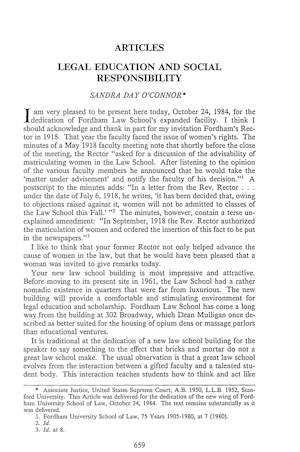By Justice Sandra Day O'Connor
Legal Education and Social Responsibility / The Moral Role of the Lawyer
October 24, 1984

DISCLAIMER: This text has been transcribed automatically and may contain substantial inaccuracies due to the limitations of automatic transcription technology. This transcript is intended only to make the content of this document more easily discoverable and searchable. If you would like to quote the exact text of this document in any piece of work or research, please view the original using the link above and gather your quote directly from the source. The Sandra Day O'Connor Institute does not warrant, represent, or guarantee in any way that the text below is accurate.
Transcript
(Excerpt, Automatically generated)
LEGAL EDUCATION AND SOCIAL RESPONSIBILITY
SANDRA DAY O'CONNOR*
I am very pleased to be present here today, October 24, 1984, for the dedication of Fordham Law School's expanded facility. I think I should acknowledge and thank in part for my invitation Fordham's Rec tor in 1918. That year the faculty faced the issue of women's rights. The minutes of a May 1918 faculty meeting note that shortly before the close of the meeting, the Rector "asked for a discussion of the advisability of matriculating women in the Law School. After listening to the opinion of the various faculty members he announced that he would take the 'matter under advisement' and notify the faculty of his decision."1 A postscript to the minutes adds: "In a letter from the Rev. Rector... under the date of July 6, 1918, he writes, 'it has been decided that, owing to objections raised against it, women will not be admitted to classes of the Law School this Fall.' " 2 The minutes, however, contain a terse unexplained amendment: "In September, 1918 the Rev. Rector authorized the matriculation of women and ordered the insertion of this fact to be put in the newspapers."3
I like to think that your former Rector not only helped advance the cause of women in the law, but that he would have been pleased that a woman was invited to give remarks today.
Your new law school building is most impressive and attractive. Before moving to its present site in 1961, the Law School had a rather nomadic existence in quarters that
